现在完成时中标志性的时间状语
用于现在完成时态的时间状语
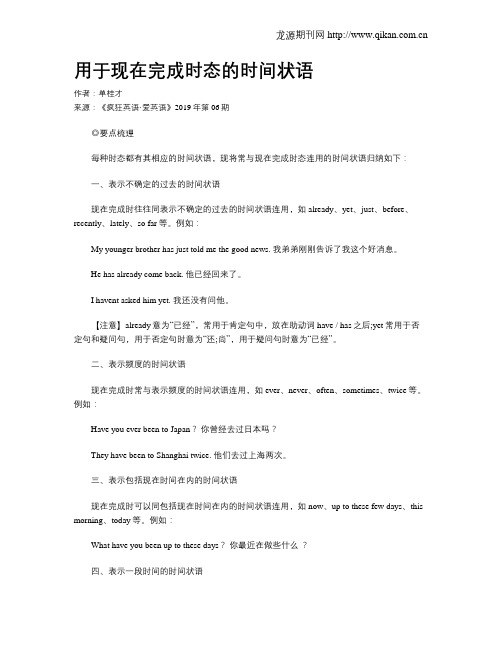
用于现在完成时态的时间状语作者:单桂才来源:《疯狂英语·爱英语》2019年第06期◎要点梳理每种时态都有其相应的时间状语,现将常与现在完成时态连用的时间状语归纳如下:一、表示不确定的过去的时间状语现在完成时往往同表示不确定的过去的时间状语连用,如already、yet、just、before、recently、lately、so far等。
例如:My younger brother has just told me the good news. 我弟弟刚刚告诉了我这个好消息。
He has already come back. 他已经回来了。
I havent asked him yet. 我还没有问他。
【注意】already意为“已经”,常用于肯定句中,放在助动词have / has之后;yet常用于否定句和疑问句,用于否定句时意为“还;尚”,用于疑问句时意为“已经”。
二、表示频度的时间状语现在完成时常与表示频度的时间状语连用,如ever、never、often、sometimes、twice等。
例如:Have you ever been to Japan?你曾经去过日本吗?They have been to Shanghai twice. 他们去过上海两次。
三、表示包括现在时间在内的时间状语现在完成时可以同包括现在时间在内的时间状语连用,如now、up to these few days、this morning、today等。
例如:What have you been up to these days?你最近在做些什么?四、表示一段时间的时间状语现在完成时可以与由for或since引导的时间状语连用,表示持续的动作或状态。
表示持续性的动词有wait、know、stay、live、teach、be、learn等。
1.for+一段时间,强调行为延续了多久,不可接时间点。
例如:I have been in the army for more than three years. 我在部队已经待了三年多了。
使用现在完成时的10类典型标志
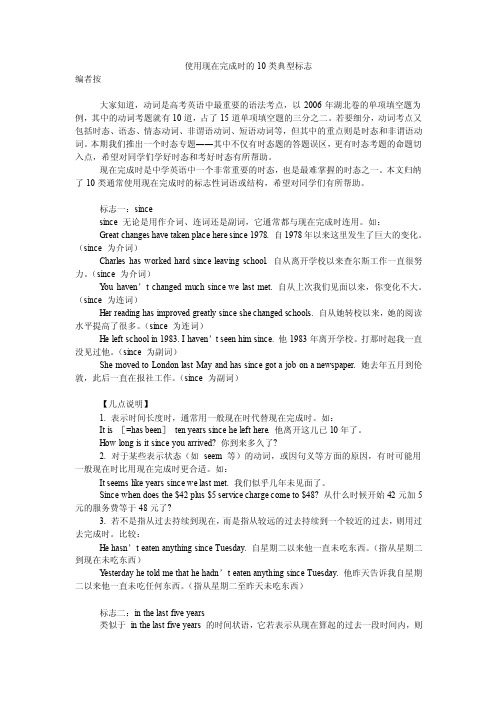
使用现在完成时的10类典型标志编者按大家知道,动词是高考英语中最重要的语法考点,以2006年湖北卷的单项填空题为例,其中的动词考题就有10道,占了15道单项填空题的三分之二。
若要细分,动词考点又包括时态、语态、情态动词、非谓语动词、短语动词等,但其中的重点则是时态和非谓语动词。
本期我们推出一个时态专题――其中不仅有时态题的答题误区,更有时态考题的命题切入点,希望对同学们学好时态和考好时态有所帮助。
现在完成时是中学英语中一个非常重要的时态,也是最难掌握的时态之一。
本文归纳了10类通常使用现在完成时的标志性词语或结构,希望对同学们有所帮助。
标志一:sincesince 无论是用作介词、连词还是副词,它通常都与现在完成时连用。
如:Great changes have taken place here since 1978. 自1978年以来这里发生了巨大的变化。
(since 为介词)Charles has worked hard since leaving school. 自从离开学校以来查尔斯工作一直很努力。
(since 为介词)Y ou haven’t changed much since we last met. 自从上次我们见面以来,你变化不大。
(since 为连词)Her reading has improved greatly since she changed schools. 自从她转校以来,她的阅读水平提高了很多。
(since 为连词)He left school in 1983. I haven’t seen him since. 他1983年离开学校。
打那时起我一直没见过他。
(since 为副词)She moved to London last May and has since got a job on a newspaper. 她去年五月到伦敦,此后一直在报社工作。
(since 为副词)【几点说明】1. 表示时间长度时,通常用一般现在时代替现在完成时。
与现在完成时连用的时间状1
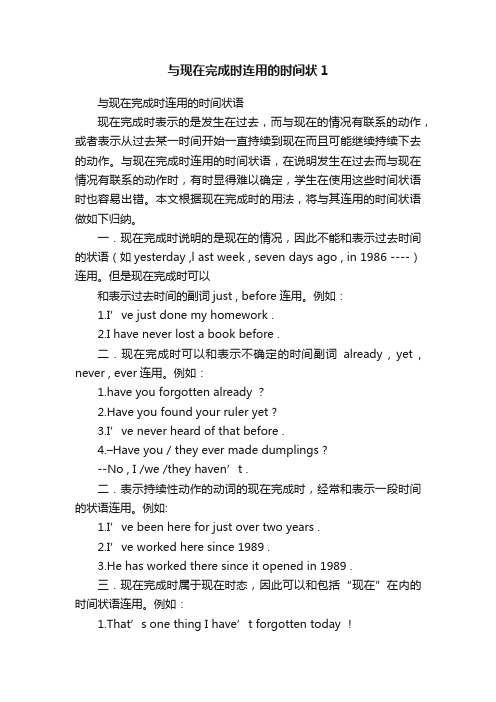
与现在完成时连用的时间状1与现在完成时连用的时间状语现在完成时表示的是发生在过去,而与现在的情况有联系的动作,或者表示从过去某一时间开始一直持续到现在而且可能继续持续下去的动作。
与现在完成时连用的时间状语,在说明发生在过去而与现在情况有联系的动作时,有时显得难以确定,学生在使用这些时间状语时也容易出错。
本文根据现在完成时的用法,将与其连用的时间状语做如下归纳。
一.现在完成时说明的是现在的情况,因此不能和表示过去时间的状语(如yesterday ,l ast week , seven days ago , in 1986 ----)连用。
但是现在完成时可以和表示过去时间的副词just , before连用。
例如:1.I’ve just done my homework .2.I have never lost a book before .二.现在完成时可以和表示不确定的时间副词already , yet , never , ever连用。
例如:1.have you forgotten already ?2.Have you found your ruler yet ?3.I’ve never heard of that before .4.–Have you / they ever made dumplings ?--No , I /we /they haven’t .二.表示持续性动作的动词的现在完成时,经常和表示一段时间的状语连用。
例如:1.I’ve been here for just over two years .2.I’ve w orked here since 1989 .3.He has worked there since it opened in 1989 .三.现在完成时属于现在时态,因此可以和包括“现在”在内的时间状语连用。
例如:1.That’s one thing I have’t forgotten today !2.We’ve been in China for over two years now .不能变被动语态的情况种种一般来说,“及物动词+宾语”组成的主动语态的句子可以变成被动语态,但并不是所有这样的句子都可以变被动语态,情况如下:一.当宾语是反身代词或是相互代词时,不能将主动句改为被动句,因为反身代词或相互代词不能作主语。
现在完成时时间状语
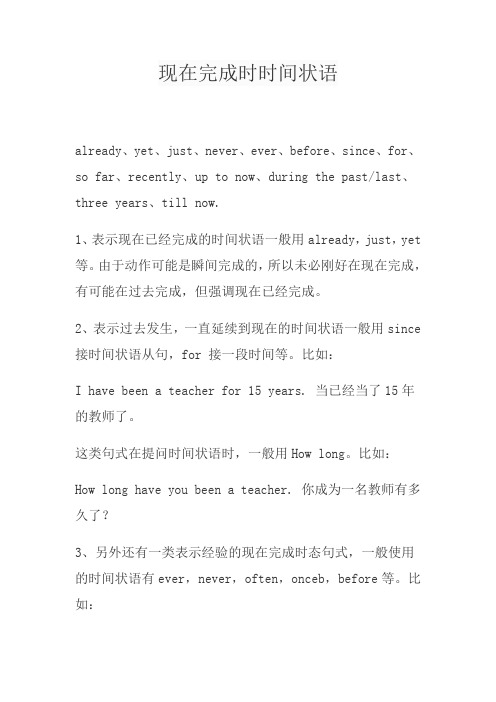
现在完成时时间状语
already、yet、just、never、ever、before、since、for、so far、recently、up to now、during the past/last、three years、till now.
1、表示现在已经完成的时间状语一般用already,just,yet 等。
由于动作可能是瞬间完成的,所以未必刚好在现在完成,有可能在过去完成,但强调现在已经完成。
2、表示过去发生,一直延续到现在的时间状语一般用since 接时间状语从句,for 接一段时间等。
比如:
I have been a teacher for 15 years. 当已经当了15年的教师了。
这类句式在提问时间状语时,一般用How long。
比如:How long have you been a teacher. 你成为一名教师有多久了?
3、另外还有一类表示经验的现在完成时态句式,一般使用的时间状语有ever,never,often,onceb,before等。
比如:
He has ever been a teacher. 他曾经是一名教师。
(意指他现在已经1不是一名教师了。
)
He has never been a teacher. 他不曾当过教师。
(意指他过去和现在都不是一名教师。
)。
一般过去时和现在完成时的标志性时间状语教学文案

现在完成时
She has already called the police. The police told her: ''You husband has just run away.'' She asked: ''Have you found out where he is going yet?'' "Not yet, but we will." The police officer promised her. "How long have you known the truth?" The officer asked. "For two weeks." Su''I'm very sorry. We have never thought the killer should be him before.''
现在完成时
Susan cried out: “Why? Why are you so cruel? So far/until now/by now, I have lost my father, my mother, my brother, my children, and my husband. In the past thirty years, my life has been a total tragedy. You are just giving a lecture…why do you have to make me such a poor woman?”
此课件下载可自行编辑修改,仅供参考! 感谢您的支持,我们努力做得更好!谢谢
一般过去时和现在完成时的标志性时间状 语
现在完成时的时间状语
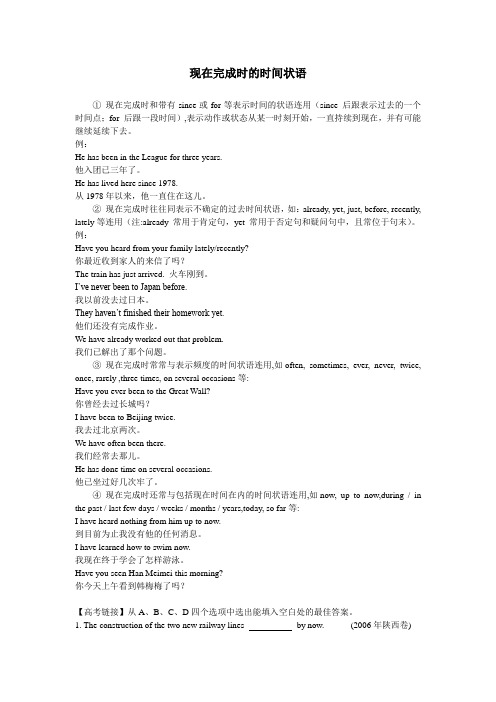
现在完成时的时间状语①现在完成时和带有since或for等表示时间的状语连用(since 后跟表示过去的一个时间点;for 后跟一段时间),表示动作或状态从某一时刻开始,一直持续到现在,并有可能继续延续下去。
例:He has been in the League for three years.他入团已三年了。
He has lived here since 1978.从1978年以来,他一直住在这儿。
②现在完成时往往同表示不确定的过去时间状语,如:already, yet, just, before, recently, lately等连用(注:already 常用于肯定句,yet 常用于否定句和疑问句中,且常位于句末)。
例:Have you heard from your family lately/recently?你最近收到家人的来信了吗?The train has just arrived. 火车刚到。
I’ve never been to Japan before.我以前没去过日本。
They haven’t finished their homework yet.他们还没有完成作业。
We have already worked out that problem.我们已解出了那个问题。
③现在完成时常常与表示频度的时间状语连用,如often, sometimes, ever, never, twice, once, rarely ,three times, on several occasions等:Have you ever been to the Great Wall?你曾经去过长城吗?I have been to Beijing twice.我去过北京两次。
We have often been there.我们经常去那儿。
He has done time on several occasions.他已坐过好几次牢了。
现在完成时的时间状语信号词
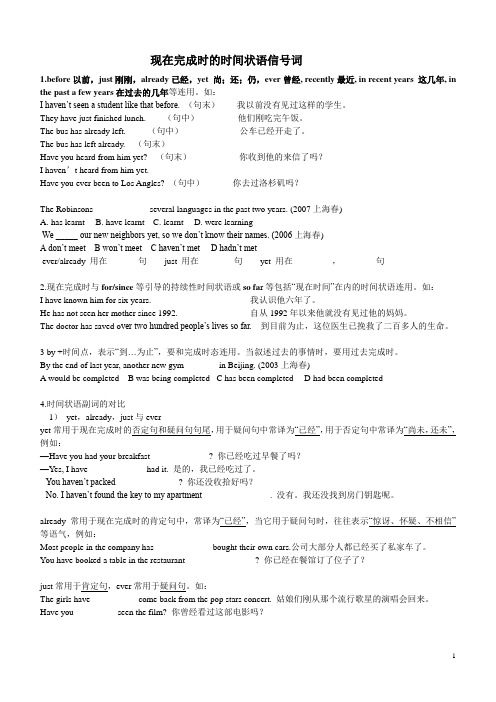
现在完成时的时间状语信号词1.before以前,just刚刚,already已经,yet 尚;还;仍,ever曾经, recently最近, in recent years 这几年, in the past a few years在过去的几年等连用。
如:I haven’t seen a student like that before. (句末)我以前没有见过这样的学生。
They have just finished lunch. (句中)他们刚吃完午饭。
The bus has already left. (句中)公车已经开走了。
The bus has left already. (句末)Have you heard from him yet? (句末)你收到他的来信了吗?I haven’t heard from him yet.Have you ever been to Los Angles? (句中)你去过洛杉矶吗?The Robinsons _________ several languages in the past two years. (2007上海春)A. has learntB. have learntC. learntD. were learningWe _____ our new neighbors yet, so we don’t know their names. (2006上海春)A don’t meetB won’t meetC haven’t metD hadn’t metever/already 用在_______句just 用在________句yet 用在________ ,________句2.现在完成时与for/since等引导的持续性时间状语或so fa r等包括“现在时间”在内的时间状语连用。
如:I have known him for six years. 我认识他六年了。
现在完成时与过去完成时讲解

现在完成时1.现在完成时态表示过去发生的动作对现在造成的影响或结果。
本时态标志词:already (“已经”,用于肯定句中,放在have /has之后或句尾);yet (“仍然”“还”,用于疑问句或否定句的句尾)just(“刚刚”,放在have /has之后);before(“以前”,放在句尾);ever(“曾经”,放在have /has之后)never (“从没有”,在have /has之后)例句:1.Our teacher has just left.2.We have studied English already.3.I have not finished the homework yet.4.He has never been to Beijing before.例:I have just turned off the light. 我刚刚把灯关上。
(结果是灯已经关上了)She has lost her bike. 她把自行车丢了。
(影响是他现在没有自行车骑了)The rain has stopped now. 雨已经停了。
(结果是我们可以出门了)I have already read the book. 我已读过这本书了。
(结果是已知道这本书的内容)She has had a good education. 她受到过良好的教育。
(影响是她文化水平高,有修养)2.某个动作从过去已经开始,一直持续到现在,还有可能持续到将来.(也可能不继续下去),常同包括现在在内的时间状语连用,如:today, now, this week, this morning, these days, this afternoon, recently, so far等动作的持续性要通过一段时间来表示一段时间的表达方法有两种:for: +一段时间 for a year for two weeks for three yearsSince +过去的某一时刻, since nine since last weekSince +一般过去时态的时间状语从句 since you came ; since you got hom e.例:We have had much snow this winter. 今年冬天多雪。
关于现在完成时的时间状语

关于现在完成时的时间状语一..现在完成时说明的是现在的情况,属于现在时。
因而不能与表示过去具体时间的时间状语连用,如不可与yesterday, last week, three years ago, in 1990, at eight o’clock等之类的时间状语连用。
这类时间状语通常是与过去(一般)时连用。
、例如:----Has he come back yet?----Yes, he came back yesterday?二.现在完成时通常可与表示过去不确定时间的时间状语连用,如already, yet, just, before等副词时间状语。
例子见上述“主要用法”中。
例如:1)I have already returned the pen to him.2)Have you washed my clothes yet? ----Yes, I have just washed them.3)I have seen the man before.说明:before有时也可用于一般过去时(这与用现在完成时意思差不多),如I told you before.我早就告诉过你。
另外,already和yet有时也可用于一般现在时,如It’s eight already./He isn’t back yet (=He hasn’t come back yet).三. 现在完成时通常可以与包括“现在”在内的表示一段时间的时间状语连用,如since..., for...;ever,never, recently(最近),today, this week (year), these days (weeks, years), in/during the last/past two years, so far等。
例如:1)We have known each other since we came to the school.2)I have collected ten stamps this week[these weeks].3)Have you seen him these days?说明:ever, never有时也可用于一般过去时(这与用现在完成时意思差不多),如I never saw the man.四. 比较下列几组用法的区别⑴already与yet①一般情况下,already表示“已经”,主要用于肯定陈述句,一般在句中;yet表示“已经”或“仍然,还”是用于疑问句或否定句,一般在句末。
现在完成时的时间状语及其用法

现在完成时的时间状语及其用法
时间使用
1与现在有关的过去点时间recently,lately,already,yet,before,still
2与现在有关的频度时间ever,never,once,twice,three times,several times, often,seldom,always,time and time again
3与过去有关的现在点时间just,now,today,tonight,this week,this year
this morning,this afternoon,this evening,
this month,this May,this October,this November
1若想强调动作从何时开始(ever)since
2若想强调动作持续了多久for(a day,several months,many years,,how long) for( two hours, six months, quite a long time)
3若想强调整体的时间all (morning,night,day,year,these years,my life)all(the while,these days,these ten days)
4若想强调与过去有关到现在的一段时间up to now,up to the present,till now,until now, so far, in the last few years,in the past 30 years ,these days,these weeks,these years。
现在完成时的时间状语
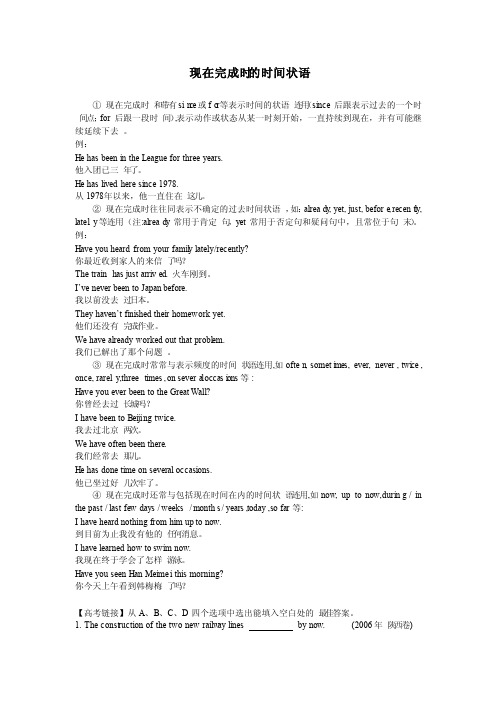
现在完成时的时间状语①现在完成时和带有sin ce或fo r等表示时间的状语连用(since后跟表示过去的一个时间点;for 后跟一段时间),表示动作或状态从某一时刻开始,一直持续到现在,并有可能继续延续下去。
例:He has been in the League for threeyears.他入团已三年了。
He has livedhere since1978.从1978年以来,他一直住在这儿。
②现在完成时往往同表示不确定的过去时间状语,如:alread y, yet, just, before, recent l y, lately等连用(注:alread y 常用于肯定句,yet 常用于否定句和疑问句中,且常位于句末)。
例:Have you heardfrom your family lately/recent ly?你最近收到家人的来信了吗?The trainhas just arrived. 火车刚到。
I’veneverbeen to Japanbefore.我以前没去过日本。
They haven’tfinish ed theirhomewo rk yet.他们还没有完成作业。
We have alread y worked out that proble m.我们已解出了那个问题。
③现在完成时常常与表示频度的时间状语连用,如often, someti mes, ever, never, twi ce, once, rarely ,threetimes, on severa l occasi ons等:Have you ever been to the GreatWall?你曾经去过长城吗?I have been to Beijin g twice.我去过北京两次。
现在完成时态的时间状语
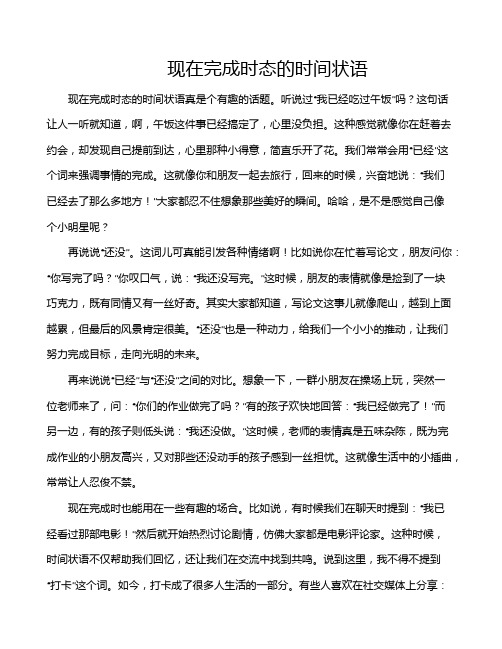
现在完成时态的时间状语现在完成时态的时间状语真是个有趣的话题。
听说过“我已经吃过午饭”吗?这句话让人一听就知道,啊,午饭这件事已经搞定了,心里没负担。
这种感觉就像你在赶着去约会,却发现自己提前到达,心里那种小得意,简直乐开了花。
我们常常会用“已经”这个词来强调事情的完成。
这就像你和朋友一起去旅行,回来的时候,兴奋地说:“我们已经去了那么多地方!”大家都忍不住想象那些美好的瞬间。
哈哈,是不是感觉自己像个小明星呢?再说说“还没”。
这词儿可真能引发各种情绪啊!比如说你在忙着写论文,朋友问你:“你写完了吗?”你叹口气,说:“我还没写完。
”这时候,朋友的表情就像是捡到了一块巧克力,既有同情又有一丝好奇。
其实大家都知道,写论文这事儿就像爬山,越到上面越累,但最后的风景肯定很美。
“还没”也是一种动力,给我们一个小小的推动,让我们努力完成目标,走向光明的未来。
再来说说“已经”与“还没”之间的对比。
想象一下,一群小朋友在操场上玩,突然一位老师来了,问:“你们的作业做完了吗?”有的孩子欢快地回答:“我已经做完了!”而另一边,有的孩子则低头说:“我还没做。
”这时候,老师的表情真是五味杂陈,既为完成作业的小朋友高兴,又对那些还没动手的孩子感到一丝担忧。
这就像生活中的小插曲,常常让人忍俊不禁。
现在完成时也能用在一些有趣的场合。
比如说,有时候我们在聊天时提到:“我已经看过那部电影!”然后就开始热烈讨论剧情,仿佛大家都是电影评论家。
这种时候,时间状语不仅帮助我们回忆,还让我们在交流中找到共鸣。
说到这里,我不得不提到“打卡”这个词。
如今,打卡成了很多人生活的一部分。
有些人喜欢在社交媒体上分享:“我已经打卡这家餐厅!”这不仅仅是吃饭,更是一种身份的象征。
大家都想要展示自己生活的精彩,哪怕只是为了一份美食。
有时,朋友间的调侃也是很有趣的。
你可能会遇到这样一种情况:“你最近在忙什么?”你自信满满地说:“我已经忙到飞起来了!”这时候,朋友可能会半开玩笑地说:“那你一定得记得休息啊!”生活中,幽默感就是那么重要,能让人轻松面对各种压力。
用于现在完成时态的时间状语
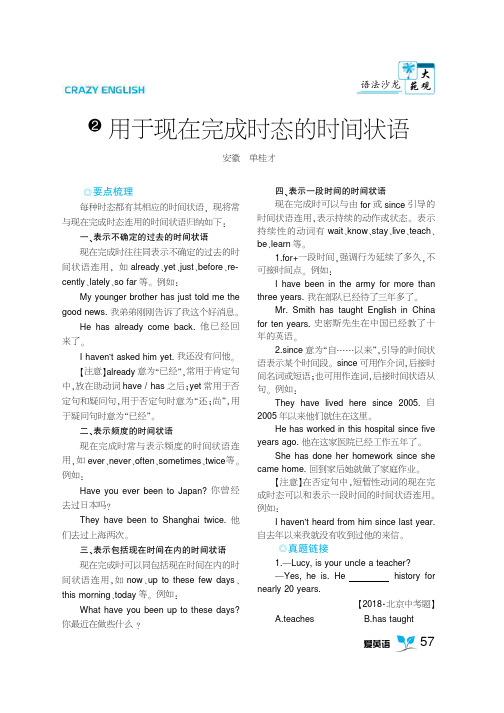
爱英语❷用于现在完成时态的时间状语安徽单桂才◎要点梳理每种时态都有其相应的时间状语,现将常与现在完成时态连用的时间状语归纳如下:一、表示不确定的过去的时间状语现在完成时往往同表示不确定的过去的时间状语连用,如already 、yet 、just 、before 、re ⁃cently 、lately 、so far 等。
例如:My younger brother has just told me the good news.我弟弟刚刚告诉了我这个好消息。
He has already come back.他已经回来了。
I haven ’t asked him yet.我还没有问他。
【注意】already 意为“已经”,常用于肯定句中,放在助动词have /has 之后;yet 常用于否定句和疑问句,用于否定句时意为“还;尚”,用于疑问句时意为“已经”。
二、表示频度的时间状语现在完成时常与表示频度的时间状语连用,如ever 、never 、often 、sometimes 、twice 等。
例如:Have you ever been to Japan?你曾经去过日本吗?They have been to Shanghai twice.他们去过上海两次。
三、表示包括现在时间在内的时间状语现在完成时可以同包括现在时间在内的时间状语连用,如now 、up to these few days 、this morning 、today 等。
例如:What have you been up to these days?你最近在做些什么?四、表示一段时间的时间状语现在完成时可以与由for 或since 引导的时间状语连用,表示持续的动作或状态。
表示持续性的动词有wait 、know 、stay 、live 、teach 、be 、learn 等。
1.for+一段时间,强调行为延续了多久,不可接时间点。
例如:I have been in the army for more than three years.我在部队已经待了三年多了。
现在完成时

现在完成时讲解1表示说话之前已经完成的动作,而且这个动作的结果对现在仍有影响;或表示过去已经开始而持续到现在的动作与状态。
1.构成2.用法(1)表示动作发生在,但对现在e.g. .他已把门锁了。
(门是关闭的)e.g. .他已去了上海。
(现在不在这里)(2)表示从过去某时起一直e.g. .我们学英语已有五年了。
3.现在完成时与时间状语搭配(1) 现在完成时可以和表示从过去某时刻延续到现在(包括“现在”在内)的一段时间的状语连用。
如today, this morning (month , week 等),recently, since……,these few days(weeks 等),in the past few years (months), for a long time等。
e.g. His father has been a teacher for a long time. 他父亲当老师已经很久了。
e.g. I have spent 50 dollars in buying new clothes this week.这个星期我已经花了50美元去买新衣服。
(2) 现在完成时还常与表示不确定的时间状语连用,如(已经),(曾经),often(常常),(还没有),once(一次),twice(两次)等连用。
e.g. They have gone to the village twice. 他们已经去过这个村庄两次。
e.g. Jane hasn’t finished her homework yet. 简还没有完成她的家庭作业。
4.现在完成时和一般过去时的差别如果谈一件已经发生的事只考虑对现在的影响,不考虑什么时候发生,就用;如果单纯谈一个过去的动作,不涉及对现在的影响,就用。
(1)The train has arrived.火车已经到了。
(没有明确地表示过去的时间状语)The train arrived half an hour ago.火车是半小时前到的。
现在完成时的时间状语
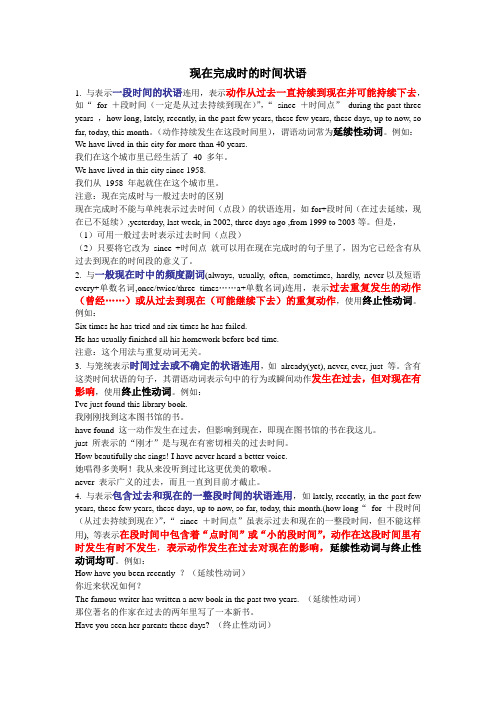
现在完成时的时间状语1. 与表示一段时间的状语连用,表示动作从过去一直持续到现在并可能持续下去,如“for +段时间(一定是从过去持续到现在)”,“since +时间点”during the past three years ,how long, lately, recently, in the past few years, these few years, these days, up to now, so far, today, this month。
(动作持续发生在这段时间里),谓语动词常为延续性动词。
例如:We have lived in this city for more than 40 years.我们在这个城市里已经生活了40 多年。
We have lived in this city since 1958.我们从1958 年起就住在这个城市里。
注意:现在完成时与一般过去时的区别现在完成时不能与单纯表示过去时间(点段)的状语连用,如for+段时间(在过去延续,现在已不延续),yesterday, last week, in 2002, three days ago ,from 1999 to 2003等。
但是,(1)可用一般过去时表示过去时间(点段)(2)只要将它改为since +时间点就可以用在现在完成时的句子里了,因为它已经含有从过去到现在的时间段的意义了。
2. 与一般现在时中的频度副词(always, usually, often, sometimes, hardly, never以及短语every+单数名词,once/twice/three times……a+单数名词)连用,表示过去重复发生的动作(曾经……)或从过去到现在(可能继续下去)的重复动作,使用终止性动词。
例如:Six times he has tried and six times he has failed.He has usually finished all his homework before bed time.注意:这个用法与重复动词无关。
现在完成时态的标志词
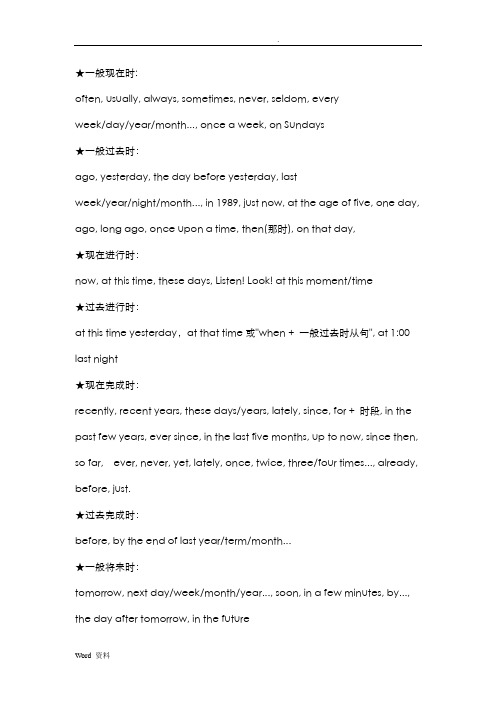
★一般现在时:often, usually, always, sometimes, never, seldom, everyweek/day/year/month..., once a week, on Sundays★一般过去时:ago, yesterday, the day before yesterday, lastweek/year/night/month..., in 1989, just now, at the age of five, one day, ago, long ago, once upon a time, then(那时), on that day,★现在进行时:now, at this time, these days, Listen! Look! at this moment/time★过去进行时:at this time yesterday,at that time或"when + 一般过去时从句", at 1:00 last night★现在完成时:recently, recent years, these days/years, lately, since, for + 时段, in the past few years, ever since, in the last five months, up to now, since then, so far, ever, never, yet, lately, once, twice, three/four times..., already, before, just.★过去完成时:before, by the end of last year/term/month...★一般将来时:tomorrow, next day/week/month/year..., soon, in a few minutes, by..., the day after tomorrow, in the future★过去将来时:the next day/morning/year...,the following month/week...现在完成时:already, yet, so far, as yet, lately ,recently,thesedays/weeks/years, until now, up to now, since+ 时间点, for+时间段, in the last/past( few years)等过去式:以前的某个时间点如yesterday,one year ago等,in the past一般现在时:always, usually, often, sometimes等现在完成时英语16种时态中不易掌握的一种时态,不仅用法法复杂,而且还通常要与某些特定的词语连用。
关于现在完成时的时间状语
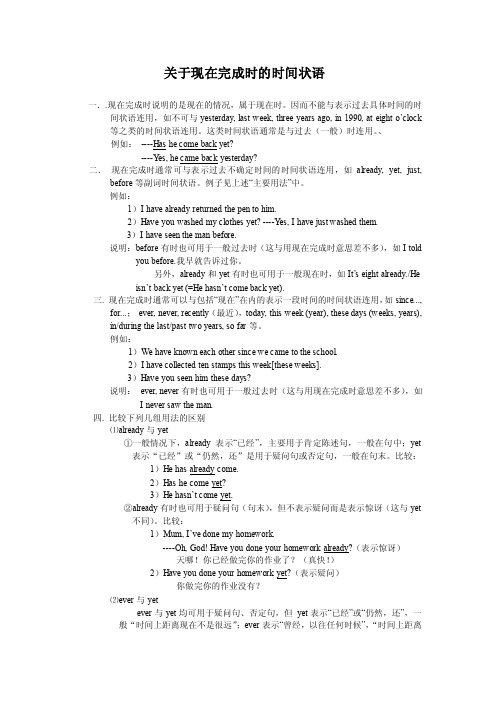
关于现在完成时的时间状语一..现在完成时说明的是现在的情况,属于现在时。
因而不能与表示过去具体时间的时间状语连用,如不可与yesterday, last week, three years ago, in 1990, at eight o’clock 等之类的时间状语连用。
这类时间状语通常是与过去(一般)时连用。
、例如:----Has he come back yet?----Y es, he came back yesterday?二.现在完成时通常可与表示过去不确定时间的时间状语连用,如already, yet, just, before等副词时间状语。
例子见上述“主要用法”中。
例如:1)I have already returned the pen to him.2)Have you washed my clothes yet? ----Y es, I have just washed them.3)I have seen the man before.说明:before有时也可用于一般过去时(这与用现在完成时意思差不多),如I told you before.我早就告诉过你。
另外,already和yet有时也可用于一般现在时,如It’s eight already./He isn’t back yet (=He hasn’t come back yet).三. 现在完成时通常可以与包括“现在”在内的表示一段时间的时间状语连用,如since...,for...;ever, never, recently(最近),today, this week (year), these days (weeks, years), in/during the last/past two years, so far等。
例如:1)We have known each other since we came to the school.2)I have collected ten stamps this week[these weeks].3)Have you seen him these days?说明:ever, never有时也可用于一般过去时(这与用现在完成时意思差不多),如I never saw the man.四. 比较下列几组用法的区别⑴already与yet①一般情况下,already表示“已经”,主要用于肯定陈述句,一般在句中;yet表示“已经”或“仍然,还”是用于疑问句或否定句,一般在句末。
一般过去时和现在完成时的标志性时间状语(共26张PPT)

戏说一般过去时和现在完成时
一般过去时
Her father died 4 days ago. Last winter, she lost her second child. Her mother passed away when she was 10 years old. Her brother killed himself in 1998. She was only 8 years old then. One day, she was kidnapped by a stranger. She was once a beautiful girl. But the stranger cut off her nose.
现在完成时
Susan cried out: “This is the first time that I have complained to you. Dear God, why are you so cruel? So far/until now/by now, I have lost my father, my mother, my brother, my children, and my husband. In the past/last thirty years, my life has been a total tragedy. All these years, I have done nothing wrong, so why do you have to make me such a poor woman?”
现在完成时
She has already called the police. The police told her: ''You husband has just run away.'' She asked: ''Have you found out where he is going yet?'' "Not yet, but we will." The police officer promised her. "How long have you known the truth?" The officer asked. "For two weeks." Susan sobbed. The officer said: ''I'm very sorry. We have never thought the killer should be him before.''
一般过去时和现在完成时的标志性时间状语
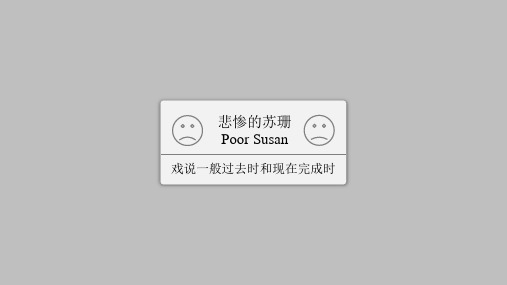
现在完成时
She has already called the police. The police told her: ''You husband has just run away.'' She asked: ''Have you found out where he is going yet'' "Not yet, but we will." The police officer promised her. "How long have you known the truth" The officer asked. "For two weeks." Susan sobbed. The officer said: ''I'm very sorry. We have never thought the killer should be him before.'过去时和现在完成时
本文档后面有精心整理的常用PPT编辑图标,以提高工作效率
一般过去时
Her father died 4 days ago. Last winter, she lost her second child. Her mother passed away when she was 10. Her brother killed himself in 1998. She was only 8 years old then. One day, she was kidnapped (绑架) by a stranger. She was once a beautiful girl. But a stranger kidnapped her and cut off her nose.
- 1、下载文档前请自行甄别文档内容的完整性,平台不提供额外的编辑、内容补充、找答案等附加服务。
- 2、"仅部分预览"的文档,不可在线预览部分如存在完整性等问题,可反馈申请退款(可完整预览的文档不适用该条件!)。
- 3、如文档侵犯您的权益,请联系客服反馈,我们会尽快为您处理(人工客服工作时间:9:00-18:30)。
现在完成时中标志性的时间状语
现在完成时在英语中的使用频率有很高,要是没学好,对英语的日常使用和各种考试而言,影响都会很大。
现在完成时不仅是初中英语中最重要也是最难掌握的一个时态,同时它也是中考英语中一个最重要的时态考点。
许多同学对现在完成时的用法似懂非懂,做题时也往往是跟着感觉走。
现在完成时表示动作发生在过去,完成在过去,但强调与现在情况仍有联系,其结果或影响仍存在。
现在完成时有一些标志性的时间状语:
一:for + 时间段;since + 时间点
They have lived in Beijing for five years.
They have lived in Beijing since 1995.
I have learned English for ten years.
二:常见的不确定的时间状语:
lately; recently, just, already, yet, up to now; till now; so far, these days, Has it stopped raining yet ?
三:在表示“最近几世纪/ 年/ 月以来……”时间状语中,谓语动词用现在完成时。
in the past few years/months/weeks/days;over the past few years;
during the last three months; for the last few centuries, through centuri es; throughout history 等
四:表示“第几次做某事,”或在“It is the best (worst, most
interesting ) +名词+that”后面跟现在完成时。
This is my first time that I have visited China.
This is the most interesting film I have ever seen.
That is the only book that he has written.。
